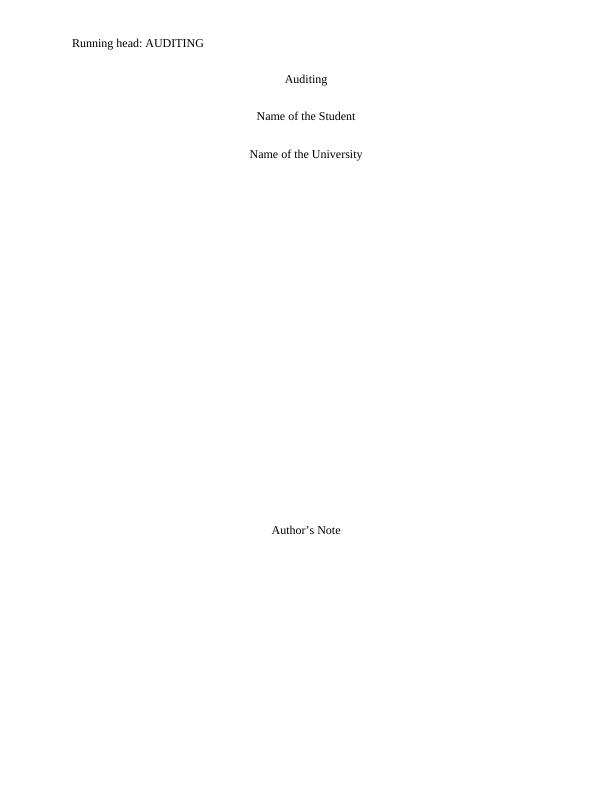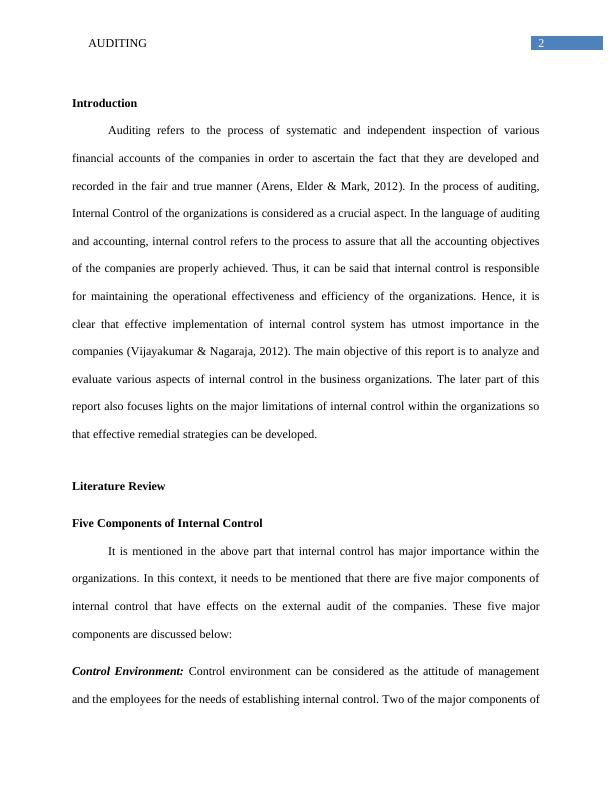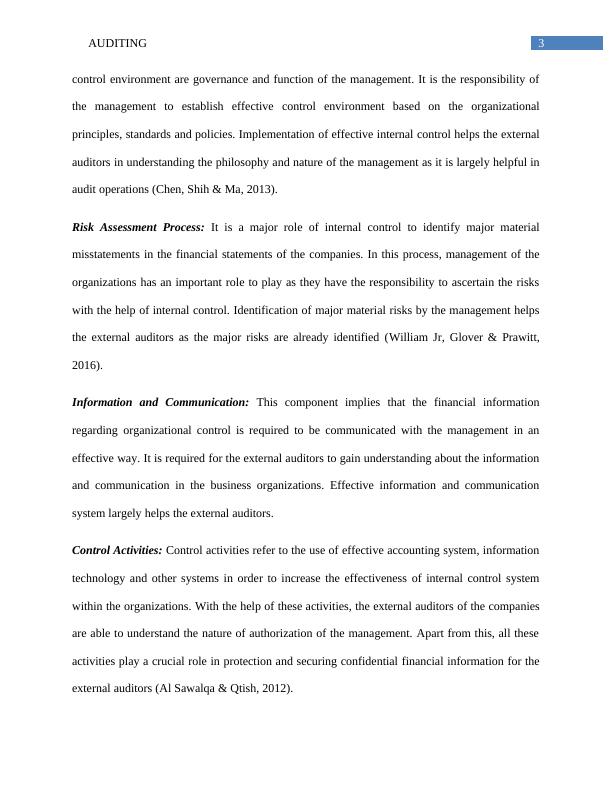Assignment on P23001 Auditing
11 Pages2310 Words123 Views
UNIVERSITY OF PORTSMOUTH
Auditing (P23001)
Added on 2020-04-15
Assignment on P23001 Auditing
UNIVERSITY OF PORTSMOUTH
Auditing (P23001)
Added on 2020-04-15
ShareRelated Documents
Running head: AUDITINGAuditingName of the StudentName of the UniversityAuthor’s Note

1AUDITINGTable of ContentsIntroduction......................................................................................................................................1Literature Review............................................................................................................................1Five Components of Internal Control..........................................................................................1Benefits of Strong Internal Control.............................................................................................3Enhancing the Performance of External Auditors.......................................................................4Case Example..............................................................................................................................5Limitations of Internal Control........................................................................................................5Conclusion.......................................................................................................................................6References........................................................................................................................................8

2AUDITINGIntroductionAuditing refers to the process of systematic and independent inspection of variousfinancial accounts of the companies in order to ascertain the fact that they are developed andrecorded in the fair and true manner (Arens, Elder & Mark, 2012). In the process of auditing,Internal Control of the organizations is considered as a crucial aspect. In the language of auditingand accounting, internal control refers to the process to assure that all the accounting objectivesof the companies are properly achieved. Thus, it can be said that internal control is responsiblefor maintaining the operational effectiveness and efficiency of the organizations. Hence, it isclear that effective implementation of internal control system has utmost importance in thecompanies (Vijayakumar & Nagaraja, 2012). The main objective of this report is to analyze andevaluate various aspects of internal control in the business organizations. The later part of thisreport also focuses lights on the major limitations of internal control within the organizations sothat effective remedial strategies can be developed. Literature ReviewFive Components of Internal ControlIt is mentioned in the above part that internal control has major importance within theorganizations. In this context, it needs to be mentioned that there are five major components ofinternal control that have effects on the external audit of the companies. These five majorcomponents are discussed below:Control Environment: Control environment can be considered as the attitude of managementand the employees for the needs of establishing internal control. Two of the major components of

3AUDITINGcontrol environment are governance and function of the management. It is the responsibility ofthe management to establish effective control environment based on the organizationalprinciples, standards and policies. Implementation of effective internal control helps the externalauditors in understanding the philosophy and nature of the management as it is largely helpful inaudit operations (Chen, Shih & Ma, 2013).Risk Assessment Process: It is a major role of internal control to identify major materialmisstatements in the financial statements of the companies. In this process, management of theorganizations has an important role to play as they have the responsibility to ascertain the riskswith the help of internal control. Identification of major material risks by the management helpsthe external auditors as the major risks are already identified (William Jr, Glover & Prawitt,2016).Information and Communication: This component implies that the financial informationregarding organizational control is required to be communicated with the management in aneffective way. It is required for the external auditors to gain understanding about the informationand communication in the business organizations. Effective information and communicationsystem largely helps the external auditors.Control Activities: Control activities refer to the use of effective accounting system, informationtechnology and other systems in order to increase the effectiveness of internal control systemwithin the organizations. With the help of these activities, the external auditors of the companiesare able to understand the nature of authorization of the management. Apart from this, all theseactivities play a crucial role in protection and securing confidential financial information for theexternal auditors (Al Sawalqa & Qtish, 2012).

End of preview
Want to access all the pages? Upload your documents or become a member.
Related Documents
Assignment on Auditing PDFlg...
|5
|783
|83
Report on Five Important Elements of Internal Control in Auditinglg...
|10
|2234
|61
Internal Control Financial Statement Report 2022lg...
|9
|2074
|29
Auditing and Assurance in Australialg...
|9
|2590
|83
Assignment on Auditing (Doc)lg...
|10
|2427
|74
Auditing of Financial Statements of Ooredoolg...
|7
|1460
|293
